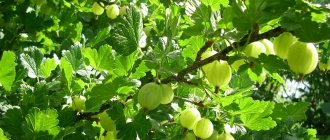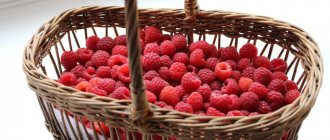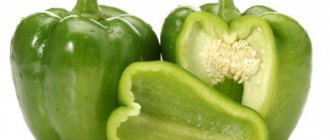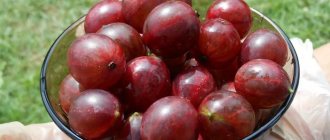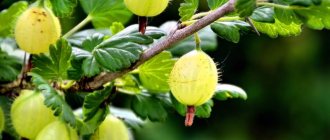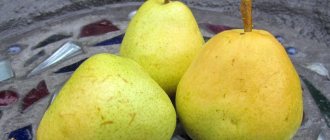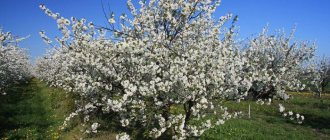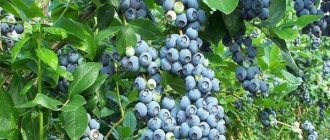Introduction
The plant is a bush with thorns that produces many shoots. This often leads to excessive thickening of the plant.
It is known that gooseberries are a light-loving crop.
A large number of extra shoots will not have the best effect on the quality of the harvest, namely, the berries will be tasteless and smaller in size. It is very important to correctly form the bush.
Vertical development of the bush
A good harvest requires careful care, which of course includes pruning . If you do not devote enough time to this procedure, the branches will become thin, begin to die, and through dense thickets of thorny branches it will be difficult to reach the dead shoots in order to remove them.
- Gooseberries are high-quality raw materials for making jams, juices, and wonderful dessert wines.
- They contain from 5 to 15% sugars, including 4.4% glucose, 4.1% fructose, 0.6% sucrose, 0.2% hemicellulose, 2% fiber, 0.7–1% pectin.
- Fresh berries contain from 30 to 60 mg per 100 g of raw material vitamin C, 0.5 - 2 - carotene, 0.56 - tocopherol, 0.03 - pyridoxine.
- Fruits with a dark red color are rich in anthocyanins, which stimulate P-vitamin activity.
- The berries contain folic acid in small quantities (0.25 mg/100g).
Berries are rich in vitamins and microelements
- Due to the content of pectin substances, gooseberry fruits are natural antioxidants; they help remove heavy metal salts from the body and normalize metabolism.
- Eating fresh berries and gooseberry products has a beneficial effect on the body and makes you healthier.
- The fruits contain succinic acid, which removes radionuclides.
Gooseberry flowers are pollinated by bees with pleasure; it is a good honey crop
As a dietary nutritious and tasty product, gooseberries are recommended for use by children and elderly people with metabolic disorders and obesity.
It is used as a choleretic and diuretic for anemia, frequent hemorrhages, and diseases of the gastrointestinal tract. The components contained in the fruits normalize blood pressure.
Growth and fruiting
When creating gooseberry varieties, European and American species are used for crossing.
- European varieties are characterized by high taste qualities of fruits, demands on soil fertility, and poor winter hardiness. They are affected by powdery mildew and other dangerous diseases.
- American varieties are distinguished by their small fruit and mediocre taste, but are less demanding on soil conditions and resistant to powdery mildew.
- Varieties created by crossing European and American species are distinguished by valuable economic and biological indicators. They are resistant to powdery mildew, have a high taste of berries, are drought-resistant, winter-hardy, and are not affected by powdery mildew.
American varieties are small-fruited but resistant
- European varieties are unusually tasty and large-fruited, but, alas, they are affected by powdery mildew.
- Bushes up to 1-1.5 m high, compact, semi-spreading and spreading.
- In one place, gooseberries can grow and bear fruit for up to 30 years, but the most productive period of bushes is up to 12 - 15 years.
Modern breeding methods have made it possible to obtain large-fruited hybrids that are resistant to diseases
In a fruit-bearing bush of 8–10 years of age and older, there can be up to 12 fruit-bearing young branches. Their number depends on the characteristics of the variety, cultivation and care of the plantings.
Stems:
- Most gooseberry varieties have thorny stems. They can be single, double or triple. Some varieties (Date, Urozhainy, Krasavets) have few or no thorns on both annual shoots and perennial branches.
- On basal shoots that form near the base of the bush, or on strong annual growth from the lower growth buds of skeletal branches, first-order branches grow only the next year.
- After a year, second-order branches form on these branches. The next year, third-order growths develop on them, and so on. On a perennial branch there are 5–6 orders of branches.
Large-fruited gooseberry without thorns - Gulliver
Sweet varieties
Belarusian sugar
Compact, tall. The degree of thorniness is high, which is compensated by delicious dessert berries. The fruits are a rich green color with thick skin and bright veins. The weight of one fruit varies from 5 g to 8 g. Advantages of the Belarusian Sugar variety: resistance to frost and disease, excellent yield, high degree of self-fertility.
Candy
Refers to the sweetest varieties, which are assigned the maximum tasting score. Candy is the newest variety, which is characterized by high productivity (up to 6.5 kg/bush), frost resistance, immunity to anthracnose and powdery mildew. Among the disadvantages, there is an average resistance to septoria.
Amber gooseberry variety
A unique dessert variety that has won recognition not only from domestic but also from foreign gardeners, however, it is still not officially recognized. The Amber gooseberry bush is spreading, up to 1.5 m in height. The color of the berries ranges from intense yellow to light orange, the weight of one fruit is 5 g. The taste is sweet with a slight sourness, the honey aroma is pronounced. The fruits can withstand long-term transportation. Advantages: frost resistance, good survival rate after transplantation, low susceptibility to disease.
Kuršu Dzintars
Dessert variety from Latvian breeders. The pulp is unusually sweet, although the fruits themselves are small. The weight of one berry does not exceed 2.5 g. The color is yellow, the skin is thin with brightly drawn veins. Productivity of Kurshu Dzintars – 4.5 kg – 6 kg/bush. Advantages: frost resistance, good transportability, disadvantages: spreading bush, susceptibility to fungi.
Spring
An early variety with high self-fertility. The berries are yellowish-green, oval, weighing up to 5 g. The shoots are spiny, with about 1 - 3 thorns for every 0.5 m. Advantages of the Rodnik gooseberry: high yield (10 kg - 11 kg/bush), resistance to parasite attacks, good transportability. Purpose: dessert.
Honey
The Honey variety is characterized by a sweet taste with notes of honey aroma. The color of the berries is yellow, the weight of the fruit reaches 6 g. It tolerates frosts well, lacks moisture, is resistant to fungi and garden parasites, but due to the heavily thorny branches, harvesting is difficult. Productivity – 5 kg/bush.
Negus black
Chokeberry for dessert purposes. Negus black is one of the best in terms of taste, despite the medium-sized berries weighing up to 2.5 g. The bushes are tall, sometimes reaching a height of 2 m. The branches are heavily thorny, which makes picking berries difficult. Productivity – 7 kg/bush. Advantages: withstands transportation without losing its presentation, is stored for a long time, is resistant to cold, ripens quickly, does not crumble.
Also read: Rules for transplanting gooseberries
Firework
The red-fruited gooseberry Salute has high taste characteristics. Productivity – about 7 kg/bush. The berries are round, their weight varies from 3 g to 7 g. Advantages: compact bush shape, thorned only at the bottom of the branches. Disadvantage: propagation by cuttings is not possible.
Date fruit
Dessert gooseberry, the distinctive feature of which is good shelf life (more than 2 weeks), large fruit and high productivity. The berries of the Date variety are greenish-yellow at maturity, weighing up to 7 g. The pulp is sugary and sour. The skin is dense, which facilitates storage and transportation. The purpose of the berries is universal.
How to prune a bush
- A good pruning shears is suitable for this, you can also use a file, or use scissors with long handles.
- Do not forget that you need to prune the branches above the bud located on the inside of the branch. This procedure stimulates the growth and development of young branches.
- Hybrid gooseberry varieties are characterized by rapid bush formation. Within 4–5 years, the plants are fully formed and begin to bear fruit. By the way, when planting hybrid seedlings, it is necessary to greatly shorten the cuttings. Using this technique, in a year you will get from 4 to 6 annual shoots.
- Starting from the fifth year, caring for the plant consists of removing excess shoots that choke the bush.
- The oldest and most poorly placed skeletal branches, those lying on the ground, should be removed.
- It is worth noting that European varieties lay flowers and, accordingly, fruits on older branches.
- Such plants need to be formed with fewer skeletal branches. Leave 3 root shoots every year and remove the rest so that light reaches all branches.
- European gooseberry varieties produce the largest amount of yield on one-year-old shoots, as well as on 2- and 3-year-old shoots.
- The largest harvest is produced by the classic form of the bush, but on the other hand, tree-like gooseberries take up less space and look very beautiful.
- It is convenient to harvest from bushes grown on a trellis.
- However, recently, due to the massive separation of glass, which gnaws passages in the stems, it is easier to grow the plant as a bush, and a small one at that.
- It is necessary to constantly make many reserve layers around the perimeter of the bush in case it affects the central part. You will have young cuttings left. It's up to you to choose which approach to use for your plants.
Description of the most popular varieties for the Moscow region and central Russia
Grushenka
Gooseberry variety Grushenka
Medium-sized shrub with drooping branches. There are practically no thorns on the shoots. The berries are medium-sized, weighing on average 5 grams, pear-shaped, and the color changes as the fruit ripens (from pale red to deep purple). The variety is perfect for growing in central Russia; it can easily tolerate frost, winter cold and drought. Is immune to many diseases.
Russian yellow
Gooseberry variety Russian yellow
A low bush with medium spreading, strewn with thorns over the entire area. Bears pear-shaped yellow fruits weighing up to 6 grams . Characterized by the presence of a thin waxy coating. The variety has excellent tolerance to sudden changes in temperature, frost and drought. Self-fertile, not affected by many common diseases.
Amber
Gooseberry variety Amber
The tall shrub can reach 1.5 meters in height. The crown is thick and spreading, and there are also many prickly thorns on it. But all these shortcomings are compensated by tasty and beautiful fruits. The berries are yellow-orange in color and oblong in shape, weighing 5-6 grams on average . Amber gooseberries are early varieties and have very high yields. This shrub also tolerates frost and drought well.
Kolobok
Gooseberry variety Kolobok
A medium-sized shrub with thorns, which are located singly, most often on the lower part of the branches. The fruits are large in size, their weight reaches 7 grams . The shape of the berries is slightly elongated, the color is pale red. The taste is pleasant, sweet and sour. The variety tolerates frost well and is resistant to anthracnose and powdery mildew.
Formation of the stem. Pros and cons
- With this formation, the gooseberry bush looks like a small tree.
- How to get this effect?
- There is nothing complicated about this method of formation. At the beginning, the largest shoot that grows vertically is selected from the bush. This will be the future trunk, and all other shoots are removed at the base.
- Next, choose the height of the stem. The most popular is about 1 m.
In subsequent years, pruning follows the same pattern:
- It is necessary to leave 4 - 6 young branches of this year, and cut off last year's branches by half.
- It is also necessary to remove branches that grow downwards, are broken or are very old (more than 7-8 years).
All side branches will also be cut to this height.
- Any shoots that appear at the base of the trunk must be removed immediately so as not to take away nutrients from the main one.
- Standard gooseberries have both advantages and disadvantages.
- The most important thing is that space is saved. For small areas this is a big plus.
- In addition, the berries on such a tree receive light evenly, ripen at the same time and are convenient to pick.
- But there are also disadvantages.
- For standard gooseberries, you need to take frost-resistant varieties: the taller the tree, the less chance it has of surviving a harsh winter compared to a low bush.
- Also, do not forget that the trunk is one shoot. Of course he's getting old. Standard gooseberries will last up to 12 years with proper care.
Taking into account the fragility of the standard gooseberry culture and the damage caused by glassware, it is recommended to graft gooseberries to form a standard onto golden currants. Firstly, it is much more durable and frost-resistant, and secondly, there are no difficulties with the constant removal of shoots, since currants produce much less of it. In addition, the currant root is stronger, so the gooseberries on this bush will be larger.
Classification of varieties by ripening time
To provide the family with tasty and healthy berries for the whole season, 1–2 gooseberry bushes of different ripening periods are planted on the plot. It should be taken into account that the early ripening crop begins to bloom in April. For cold regions this option is dangerous. Early ovaries may be damaged by frost.
Early ripening
The group of early-ripening varieties includes gooseberries, whose harvest ripening dates fall at the beginning or middle of June. Several worthy representatives are shown in the table.
| Name | a brief description of |
| Spring | The variety is high-yielding, resistant to cold and disease, but has one drawback. After ripening, the fruits must be removed in time. The berries do not fall off, but lose their taste. |
| Grandee | Gooseberries bear large red fruits weighing up to 15 g. The plant has small thorns. |
| Affectionate | The thornless variety produces berries weighing 7 g. The bushes are small and compact. |
| Gentle | The characteristics are similar to the Laskovy variety. The difference is the presence of small spines. The crop needs regular pruning. |
| Pax | The culture of English selection bears fruits weighing up to 10 g. There are few thorns on the young branches. |
| Favorite | The shrub is rarely attacked by insects and is resistant to spheroteca. The berries become yellow when ripe. Fruit weight is about 4 g. |
Mid-season
Medium-ripening gooseberries are ready for harvest from mid-July. Let's look at the worthy representatives of this group in the table.
| Name | a brief description of |
| Nekrasovsky | The bushes are moderately spreading. Ripe berries have a plum flavor. The purpose is universal. |
| Garkate | Variety of Latvian selection. Ripening fruits become dark purple in color. Berry weight is about 4 g. |
| Nova | Gooseberries have no thorns on their fruiting branches. The mass of the red berry is more than 6.5 g. |
| Purman | Gooseberry resists spheroteca, but is weak to harsh winters. The buds freeze in the cold. The cherry-colored fruits with small fibers weigh up to 4.5 g. |
| Souvenir | Gooseberries are almost never affected by diseases, tolerate winters well, and quickly grow new shoots. The fruits weigh about 9 g. |
Late ripening
The late gooseberry harvest occurs at the end of July - beginning of August. Let's look at the worthy representatives of this group in the table.
| Name | a brief description of |
| Korshudin | The fruits do not have a pronounced taste, are small, with a high presence of acid. The variety is intended for amateurs. The bush grows thin thorns. |
| Defender | The high-yielding variety can withstand frosty winters. Disease resistance is average. Bushes with needles. |
| Mucurines | The branches have small thorns. Productivity is high. Weight of berries is more than 7 g. |
| Pokrovsky | The fruits are shaped like pears. Gooseberries are endowed with excellent immunity and are resistant to bad weather conditions. |
| Seedling Change | The bush grows up to 1.8 m high. There are small thorns on the branches. The fruits are pink on top and green on the inside. |
Agrotechnical techniques
- To eliminate the first signs of powdery mildew, the affected shoots are simply cut out.
- Wild shoots on fruit bushes are also pruned. Excess young shoots on gooseberry bushes are also removed.
- At the stage of ripening of berries, the bushes can be covered with straw.
- If shoots appear that grow well, but droop and come into contact with the soil, they can be buried and propagated in this way using rooted layering.
- This method is suitable for all varieties of gooseberries.
- Do not rush to cut off young bushes from the mother plant or dig them up, but simply spread them apart.
Digging up side layers is one of the techniques that helps protect gooseberry shoots from glass. The caterpillar cannot settle inside the thin shoots that form on the coppice plants.
- Such branches bear fruit stably - they are connected to the bush, and continue to develop as part of it, and they also receive nutrition from new young roots, so the berries are larger.
- It is better to water shrubs rarely, but abundantly; the soil should not dry out. With frequent surface watering, the result will be completely different - only the top layer of soil will get wet. This will lead to the development of a superficial root system, which, in turn, will provoke rapid freezing of the roots in winter frosts, as well as their rapid drying out in the summer heat.
- Another rule that should not be forgotten:
- Apply fertilizer only to well-loosened, moist soil, so the beneficial substances will reach their goal much faster.
- It is advisable to mulch the shrubs in the root system area and water them in the root grooves.
- Systematically remove old, low-productive branches, thereby creating favorable conditions for increased growth of new shoots, which will have a positive effect on productivity.
Why do gooseberries need thorns?
Indeed, a special feature of gooseberry bushes are their thorns. They protect the branches from direct sunlight, condensation accumulates on them, so the plant does not overheat even on a hot day. In addition, the thorns prevent ungulates from getting to the sweet berries, thereby providing the plant with increased survival among its competitors.
But the dacha plot is an inviolable territory for elk and deer. Breeders have the opportunity to outwit nature and create gooseberry species with almost no thorns.
Such crops appeared and over time received active support from gardeners. And the classification of plants according to the presence or absence of thorns on the bush includes thornless, medium thorny and strongly thorny varieties.
Thorns on gooseberries make caring for the crop difficult - it’s difficult to pick berries, constantly risking getting pricked
Feeding and watering
Morning water treatments
- Fertilizer for feeding shrubs must be diluted correctly, according to the manufacturer’s recommendations.
- A high concentration will not lead to increased development of the plant, but will simply burn the roots, which may lead to its death in the near future.
- In general, watering is best done in the morning or before sunset. Under the scorching rays, moisture evaporates very quickly and a dense crust forms on the ground, which prevents oxygen from entering the soil.
Secrets of a good harvest
Generous harvest
- Growth or mixed buds are formed on each annual shoot. On growths longer than 40 cm, all lateral buds are growth buds.
- On less vigorous plants (20 – 40 cm) they are tall and mixed.
- One or two berries and a new shoot grow from the mixed bud.
- On shortened shoots (up to 3 cm) all the buds are mixed and next year each of them bears fruit and produces new growth. The same type of buds is found on fruit branches.
- The productivity of branches decreases when they become bare, growth decreases, weakened branches end their growth with the formation of a vegetative bud at the top. This happens on old branches over 7–8 years old.
- To obtain stable high yields from the bushes, it is necessary to leave the most productive 3-5 year old branches.
Classification of varieties by date of registration in the State Register
Forty-six varieties are registered in the State Register. There are old representatives of culture and many new products.
New gooseberry varieties
All new products developed in the twenty-first century are distinguished by winter hardiness and good immunity, which allows them to be grown in many regions, regardless of the climate. Breeders additionally focused on large fruit. The new varieties include the following varieties:
- White Nights;
- Defender;
- Cossack;
- Candy;
- Favorite;
- Folk;
- Spring;
- Northern Captain;
- Serenade;
- Snezhana;
- Ural emerald;
- Ural pink;
- Flamingo;
- Shershnevsky;
- Eridanus.
The new products differ in the color of the berries and other characteristics.
Old gooseberry varieties
The first varieties were bred and registered in 59 of the last century. Worthy representatives are:
- Malachite;
- Russian;
- Seedling Lefort;
- Change;
- Chelyabinsk green.
Despite the fact that gooseberries were bred a long time ago, the varieties are still popular among gardeners.
Bloom
Blooming bush
- From the mixed buds an inflorescence grows with two to three flowers (few-flowered raceme), sometimes only one flower is formed.
- In forest-steppe conditions, flowers bloom on April 20-25, in cold and protracted spring - in early May.
- Flowering occurs in the same sequence in other zones - earlier in the south, later in the northern regions.
- Flowering lasts from 5 to 8 days.
- Gooseberry varieties are self-fertile, but flowers are better fertilized if pollinated by pollen of other varieties. Therefore, it is better to grow at least 2 - 3 varieties on a personal plot.
- Bees work well on gooseberry flowers; bumblebees, wasps and flies visit them, ensuring cross-pollination
The best varieties for industrial cultivation
Such gooseberries must be transportable and resistant to cracking . After harvesting, the berries are selected and processed, then they are transported to industrial and retail outlets. Some varieties:
- Harlequin (photo below). A variety with large and sweet berries. The taste is sweet, the flesh is juicy and tender. The weight of the fruit is about 4 g, the color is red, the shape is round. Productivity is about 4 kg per 1 sq.m.
- Bitsevsky . Berry weight 4 g, elliptical shape, medium-thick skin. The color of the gooseberry is dark red or burgundy and has a waxy coating. The taste is classic, juicy and aromatic. Bitsevsky is suitable for growing in regions with variable climates.
- Reliable . Gooseberries are grown in central Russia and Siberia. It has strong immunity to fungal and viral diseases. The pulp is aromatic and sugary. The weight of gooseberries varies from 1.5 to 3 g, the color is pale pink, the peel is thin.
- Rainbow . The oval berry reaches a weight of 3 g. The shape is oval, the color is red, there are faint light stripes. The skin is of medium thickness, the flesh is sweet and sour. Raduzhny is suitable for long-distance transportation. The yield is stable, about 4k per plant.
- Northern captain . Gooseberry with an illuminating sweet and sour taste. The weight of the berry is 3-4 g, the peel is thin, the color is black with a waxy coating. It is resistant to cracking and retains its taste and commercial qualities for a long time. Productivity up to 5 kg per 1 sq.m.
Gooseberry "Harlequin"
Attention! In order for gooseberries to show excellent yield, attention is paid to agrotechnical rules. Every year, gardeners carry out pruning - leaving 3-5 of the strongest basal shoots. Frozen and weak branches are removed. It is also important to remember that gooseberries do not tolerate excess moisture. During the season it is watered only 2-3 times.
Fruit
- Varieties differ in size, shape, color, and taste of the berries.
- Fully ripe fruits are light green, pink, red, with different shades. The most valuable, nutritious berries with dark fruit color. They contain more biologically active substances of the anthocyanin group.
- Their average weight ranges from 5 to 20 grams or more.
- The fruits differ in their suitability for technical processing and fresh consumption.
- Berries with thick and dense skins are suitable for making compotes and jams, while those with thin skins are suitable for fresh consumption and for making juice.
- Depending on the purpose, the fruits are harvested at the technical ripeness stage or completely ripe.
- When picked not completely ripe, they ripen in a few days. Stored at low temperatures (cellar, refrigerator).
Gooseberry varieties resistant to powdery mildew
The most dangerous disease to which bushes are exposed is powdery mildew. Moreover, garden crops get sick quite often. Unfortunately, after illness the fruits become unusable. There are a number of crops that are resistant to this disease:
Chernomor
Mid-season gooseberry. The berries are oval, color from black to dark ruby. The bush is not spreading, it is vigorous, and there are single thorns on the shoots. The average weight of the fruit is 3 g, the yield is 4 kg per bush. Chernomor is resistant to powdery mildew and tolerates external adverse factors well. The taste of the berries is sweet and sour, the fruits are stored for a long time without losing their commercial qualities.
Northern captain
Developed for cultivation in the North-West region. The bush is tall and dense. There are no thorns on young shoots; they rarely grow on adults. The color of the berries ranges from red and rich burgundy to almost black. Fruit weight 3.5 g - 4.0 g. The skin is thick with light veins. Northern captain is cultivated both in the northern regions and in warmer areas. Advantages: tolerates frosts down to -30°C, fruits are easily removed but do not fall off, does not lose the ability to bear fruit for 20 years, is little susceptible to powdery mildew, produces up to 3.5 kg of berries per season from one bush. Disadvantage: demanding on moisture. Purpose – technical.
Also read: Caring for gooseberry bushes
Pushkinsky
The newest variety has not yet received official recognition, as it is being tested in nurseries. The degree of thorniness is low. Not susceptible to powdery mildew and other diseases. The weight of one berry reaches 4 g - 5 g, the yield is high - up to 9 kg / bush.
Malachite
Distributed in the regions of the North and Far East, adapted to the conditions of mid-latitudes. Malachite is slightly susceptible to powdery mildew, but is not resistant to septoria. The berries are green in color, with thin skin, the weight of one fruit is up to 6 g, the yield is 3 kg/bush. The purpose is technical due to the pronounced sour taste of the pulp.
Spring
Gooseberries of Belarusian breeders, distinguished by their ability to tolerate cold well, are little susceptible to powdery mildew. Advantages of the Yarovaya variety: sweet taste of the pulp, the fruits do not fall off the bush during ripening. Disadvantages: during storage, the berries lose their taste, low yield (up to 3.5 kg/bush), low fruit weight (3.5 g).
Kolobok
Bred for cultivation in any climatic zones. The shape of the berries is round, the color at technical ripeness is red, ripe fruits have a rich burgundy color. The weight of one berry is 4 g - 7 g, productivity is up to 10 kg / bush. The bun is tall, with a dense crown, and requires shaping and thinning pruning. The advantages include unpretentiousness, good adaptation to adverse climatic conditions, and immunity to diseases.
Baltic
Fruitful, the bush produces up to 13 kg of berries per season. The berries are medium-sized, weighing up to 4 g. The bushes of the Baltic variety are compact, with thorny branches. The main advantage is non-susceptibility to powdery mildew. The purpose is universal; the berries are consumed fresh or used for preparations.
Anniversary yellow
The Jubilee yellow gooseberry is vigorous, but has a compact bush shape. During the season it produces 4.0 kg - 4.5 kg of berries with a sweet and sour taste. Weight of one berry is 4 g. Advantages: high survival rate and adaptability to unfavorable factors, frost resistance, immunity to powdery mildew and pest attacks. The disadvantages include difficulty in picking berries due to the presence of sharp and long thorns in large quantities.
Masheka
Bred by Belarusian breeders. The color is brick-red, the weight of the fruit is up to 3 g, the yield is 3.5 kg/bush. The pulp is dense, with a sour taste. Advantages of the variety: immunity to powdery mildew, cold resistance. Disadvantages of Masheka gooseberries: dependence of productivity on weather factors.
Mucurines
Mukurines has excellent varietal characteristics: high productivity (7 kg/bush), large-fruited (7 g - 8 g), immunity to black spot and powdery mildew, frost resistance, suitability for both manual and mechanized harvesting.
Russian red
Bred for cultivation in all regions except the Urals. The Russian red bush is spreading and requires shaping and tying to supports. Does not suffer from powdery mildew, is winter-hardy, and is not demanding in matters of care. The weight of the berries varies from 3 g to 6 g, the yield is 2.1 kg - 5.7 kg, depending on weather conditions. Among the disadvantages, experts mention only the spreading nature of the shrub; the advantages include the high ability of self-fertility.
Jubilee
The hybrid Yubilyar is resistant to powdery mildew and belongs to the group of large-fruited gooseberries (berry weight - 6.5 g). Productivity is average - no more than 4.5 kg/bush. At the stage of technical ripeness, the berries are green; ripe fruits are yellow with a pinkish tint. The pulp is sweet and sour, the skin is thick. Advantages: winter hardiness, excellent product characteristics, ease of propagation. Disadvantage: high degree of studding.
English yellow
Gooseberries do not have large fruits and high productivity, but are able to resist diseases that destroy entire plantations. Thanks to this characteristic, the English Yellow variety is grown on an industrial scale. Productivity - 4 kg/bush, berry weight - 4 g - 6 g. At technical ripeness, the berries are green, at the stage of full ripeness - yellow. The pulp is sweet and sour, the skin is thick.
Also read: How to plant gooseberries?
White Smith
Infection-resistant gooseberry. The purpose of White Smith berries is universal. The fruits have a delicate, sweet and sour taste. The shrub is compact, low-growing (up to 1 m), and does not require special care or formative pruning. Berry weight – 4 g – 7 g, productivity – 2 kg – 4.5 kg per adult bush.
Growing seedlings
Planting new seedlings
- Gooseberries are propagated by layering or cuttings.
- Varieties of American origin or those obtained from their crossing take root better during vegetative propagation. They even reproduce from lignified cuttings.
- The varieties resistant to powdery mildew of the American type - Smena, Russky, Malachite - take root best.
- Shoots of new hybrids take root unsatisfactorily. For example, varieties of the European type - Fertile, Rubin - are almost impossible to propagate from lignified cuttings.
- The following varieties reproduce well with live bait: Urozhainy, Russian, Krasavets, Date.
Propagation by lignified cuttings
Propagation by lignified cuttings is not used for all varieties
- Seedlings harvested in autumn are planted in autumn or early spring in a greenhouse, greenhouse or open beds.
- The cuttings are cut 20 cm long. The top bud is left at soil level.
- The soil mixture in greenhouses or garden beds should be light and free-flowing. To do this, the soil is mixed with humus, peat, and fine river sand in equal proportions.
- After planting, water until the soil is completely saturated. Do not allow the soil to dry out under any circumstances.
- Before rooting begins, greenhouses are not ventilated.
- After the roots grow, the frames are gradually opened; when entering the intensive growth phase, the frames are removed. Seedlings are grown in the beds.
Planting process
- It is best to plant bushes in autumn, October or early spring before buds open.
- The best survival rate is for standard two-year-old seedlings with a well-developed root system about 20 cm long.
- In such plants, already in the first year of growing season, more than 5 strong shoots can grow, which the next year will ensure productivity in the range of 0.8 - 1 kilogram per bush.
- Planting annual seedlings delays the period when bushes enter the fruiting period by 1–2 years.
- When planting, the root collar is buried 10 cm.
- The planted bushes are well watered. After the water has seeped out, the soil is mulched.
Irrigation
This crop requires watering
With insufficient irrigation, gooseberries grow and bear fruit poorly. In waterlogged areas or in places with close groundwater, plant growth stops due to the displacement of air from the soil.
Excessive amounts of moisture inhibit the vital activity of soil microflora and also carry harmful salts from the soil to the surface.

